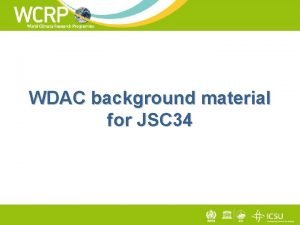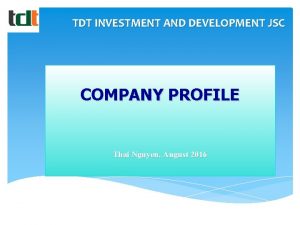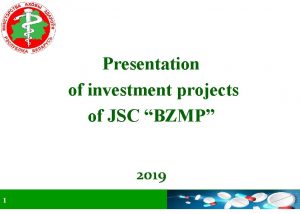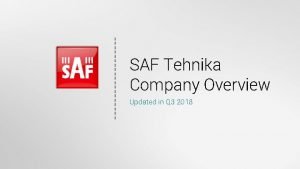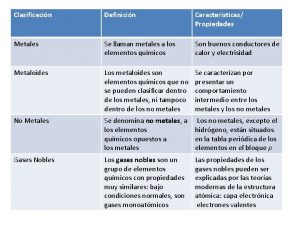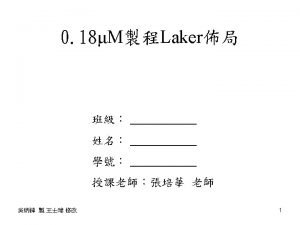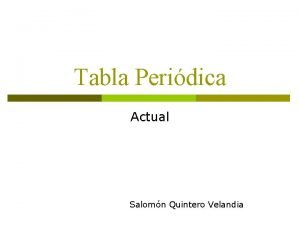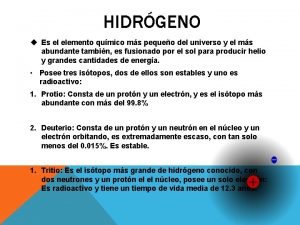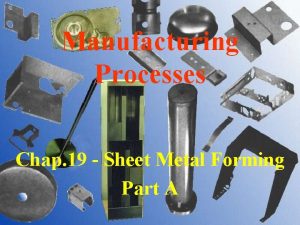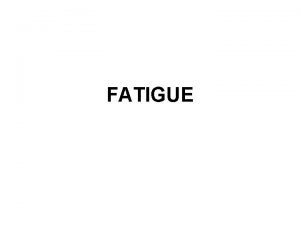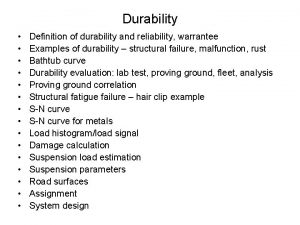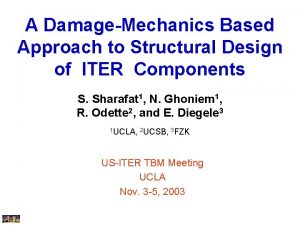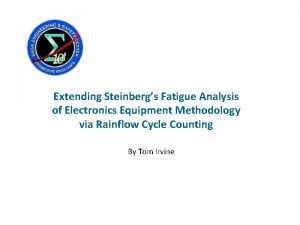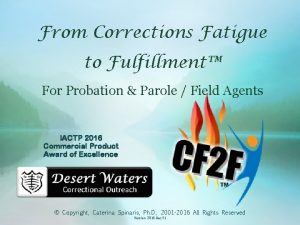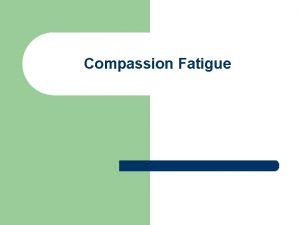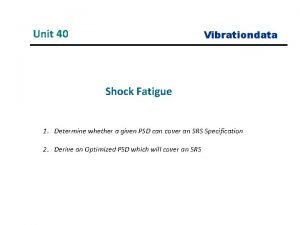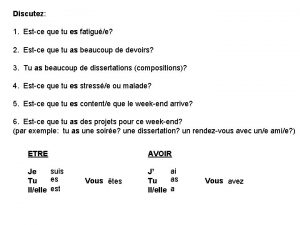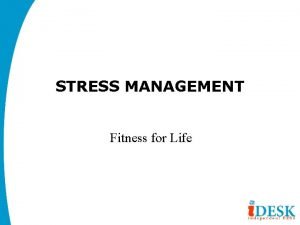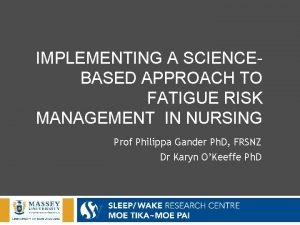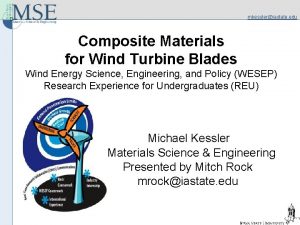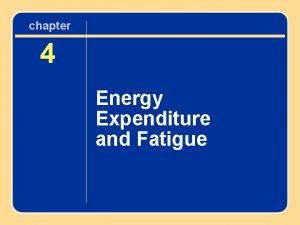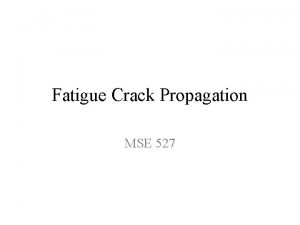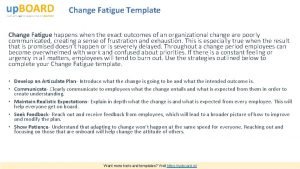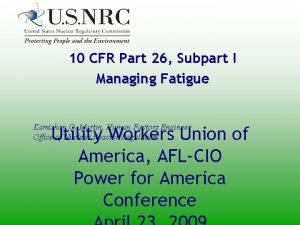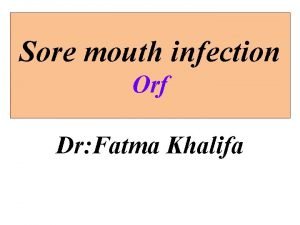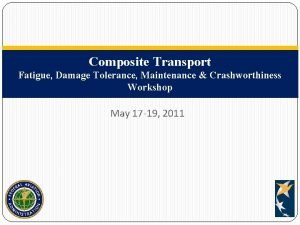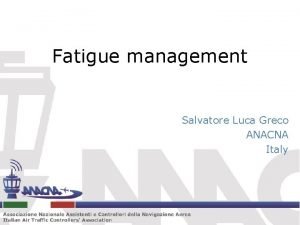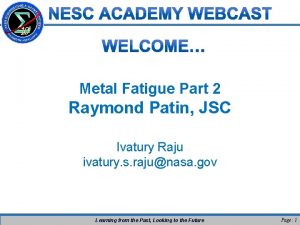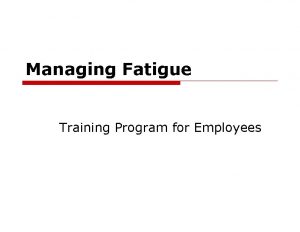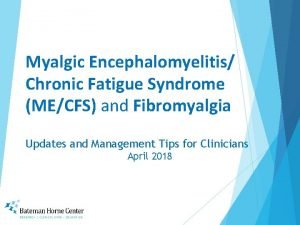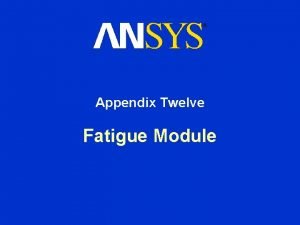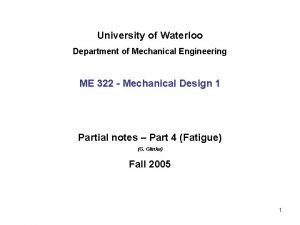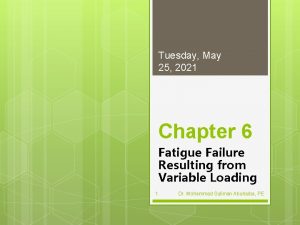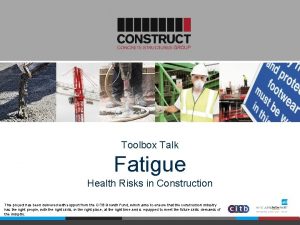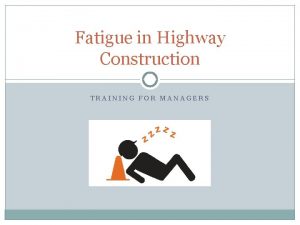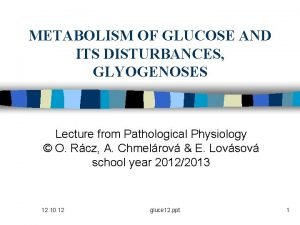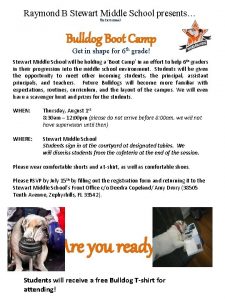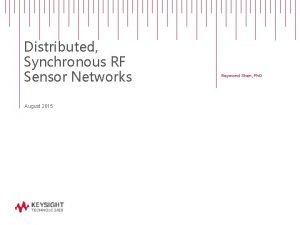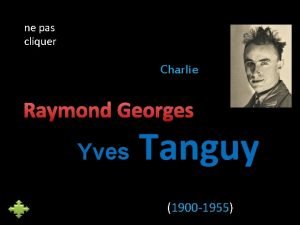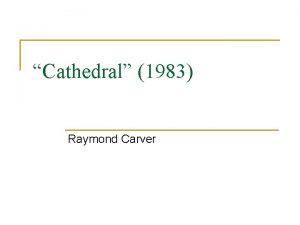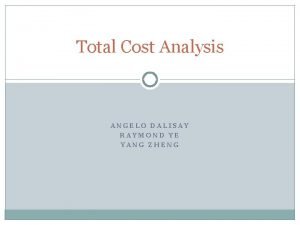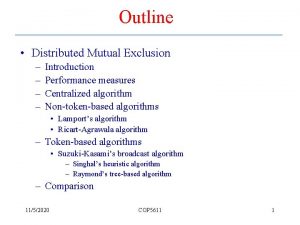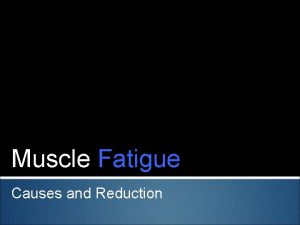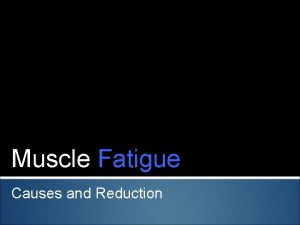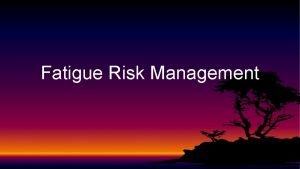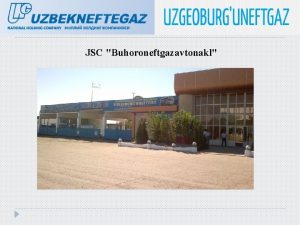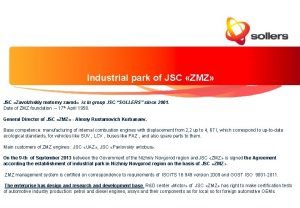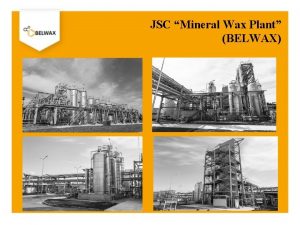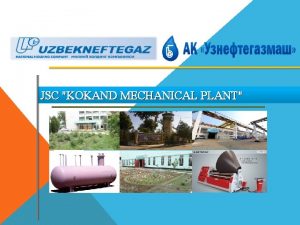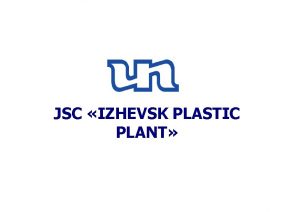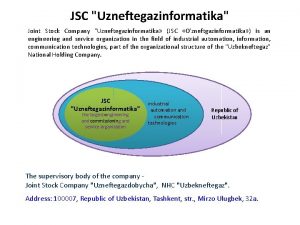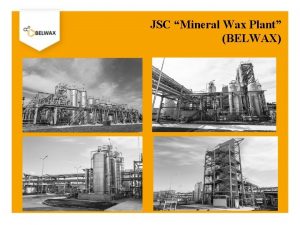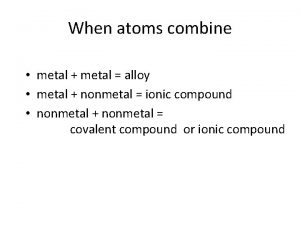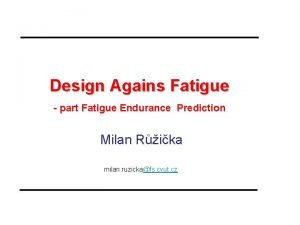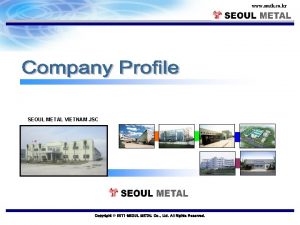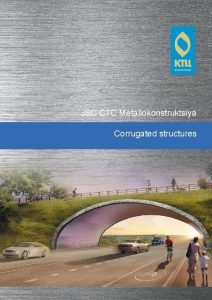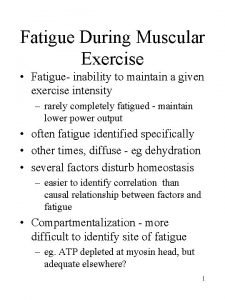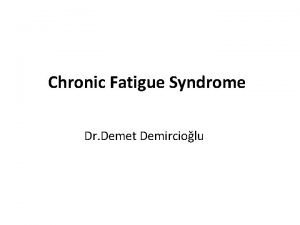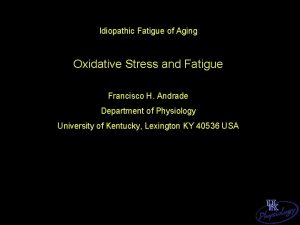Metal Fatigue Part 2 Raymond Patin JSC Ivatury


























































































- Slides: 90

Metal Fatigue Part 2 Raymond Patin, JSC Ivatury Raju ivatury. s. raju@nasa. gov Learning from the Past, Looking to the Future Page: 1

SLa. MS Webcast Series Learning from the Past, Looking to the Future

Metal Fatigue a cursory overview Part II by Raymond Patin NASA/JSC

Subject Outline • Introduction – Definition & Historical Overview • The S-N Curve • The S-N Endurance Limit • S-N Fatigue Scatter • Torsion Fatigue • Mechanics of Fatigue Damage Accumulation • Fatigue Failure Fracture Surface Features • Strain-Life • Linear Elastic Fracture Mechanics • Fatigue Life Example Problem 4

S-N Fatigue Summary 5

What is metal fatigue? The definition of "fatigue" according to ASTM* Standard E 1150 reads as follows: “The process of progressive localized permanent structural damage occurring in a material subjected to conditions that produce fluctuating stresses and strains at some point or points and that may culminate in cracks or complete fracture after a sufficient number of fluctuations. ” *ASTM – American Society for Testing and Materials Flow chart description of the metal fatigue process 6

Fatigue Damage Accumulation Process A schematic representation of the fatigue crack nucleation, initiation, and propagation phases is provided below. Fatigue crack nucleation/initiation at the surface via persistent slip bands. Small crack propagation via Mode II mechanism. Long crack propagation via Mode I mechanism. Ref. : R. I. Stephens, A. Fatemi, R. R. Stephens, H. Fuchs, “Metal Fatigue in Engineering, 2 nd ed. , ” John Wiley & Sons, 2000, pp. 51. 7

S-N curve ; Fatigue Damage Accumulation The cyclic time required to nucleate and initiate a fatigue crack consumes the majority of the overall fatigue life. Crack nucleation initiation cycles crack propagation cycles S-N curve Ref. : W. G. Barrois, Manual of Fatigue of Structures ; Fundamental and Physical Aspects, AGARD-MAN-8 -70, June 1970, pg 227. 8

Strain Life Analysis 9

Stress & Strain Concentration Factors The stress and strain linear elastic concentration factors are equal and constant. As the local response becomes nonlinear (beyond material yield) the strain concentration increases while the stress concentration decreases (as per the material response). Thus for locally nonlinear responses the material total strain (which can be measured directly) is an ideal analytical parameter. linear elastic Ref. : R. E. Stowell, Stress and Strain Concentration at a Circular Hole, NACA TN 2073, 1950, pg 11. 10

Stress-Strain Curves – Monotonic & Cyclic The elements of a monotonic (zero to max loading) and a cyclic (fully reversed) stress-strain response are provided below. In both cases the total strain can be separated into the elastic and plastic components. Cyclic - Monotonic - Stress ( ) Elas t Unl ic oadi ng Strain ( ) plastic elastic total = elastic + plastic elastic total = elastic + plastic 11

Manson-Coffin Relation Research into metal formability (late 1940’s) quantified the remaining ductility after a finite number of loading reversals to failure (very low cycle fatigue). S. S. Manson and C. L. Coffin independently formulated a relationship between applied plastic strain-range and cycles to failure (early 1950’s) ; plastic = C(N)d Ref. : Jo. Dean Morrow, J. F. Martin, N. E. Dowling, Local Stress-Strain Approach to Cumulative Fatigue Damage Analysis, UILU-ENG 74 6001, T. &A. M. Report No. 379, 1974, pg 47. 12

Strain-Life ; the Manson-Coffin-Basquin Relation Basquin defined cyclic life as power law relation of the applied stress range. Combining the Mason. Coffin relation with the Basquin relation results in the strain-life formulation ; cycles to failure defined as a function of applied elastic and plastic strain ranges. 13

Strain-Life Methodology (constant amplitude) The local cyclic strain is constrained by the large volume of elastic material which results in a displacement or strain controlled response. Ref. : N. E. Dowling, “Local Strain Approach to Fatigue”, Chapter 4. 03, Comprehensive Structural Integrity, B. Karihaloo, R. O. Ritchie, and I. Milne, overall editors, Elsevier Science Ltd. Oxford, England, 2003. 14

Linear Elastic Fracture Mechanics 15

LEFM Historical Overview 1913 – C. E. Inglis publishes “Stresses in Plate due to Presence of Cracks and Sharp Corners” which defines the stress field for 2 -D elliptical openings. 1920 – A. A. Griffith, “The Phenomena of Rupture and Flow in Solids”, proposes that fracture will occur when the strain energy released during crack extension exceeds the rate of increase in the material resistance to fracture (surface energy in Griffith’s formulation). 1948 - G. R. Irwin and E. Orowan independently modify Griffith’s criterion to include the work done in plastic deformation such that it could be applied to ductile materials/metals. 1956 – G. R. Irwin equates the strain energy release rate to the stress and displacement field in the vicinity of the crack tip (fracture process zone) as opposed to the energy balance for the entire elastic solid. 1957 – Irwin’s “Analysis of Stresses and Strains Near the End of a Crack Traversing a Plate” shows that the crack tip stress field can be characterized by the stress intensity factor K and that the stress representation is equivalent to strain energy methodology. 1961 – P. C. Paris et al. demonstrate that the stress intensity factor K is a viable parameter to characterize fatigue crack propagation rates. Ref. : Fracture Mechanics Retrospective : Early Classic Papers (1913 -1965), John M. Barson, editor, American Society for Testing and Materials, 1987, pp 1 -10. 16

Stress Intensity Factor In 2 -dimensional linear elasticity the equilibrium equations (sum forces & moments = 0), constitutive relations [ ( )], and the compatibility relations (ensures continuity between the 3 strain components and the 2 displacement variables) must be satisfied for a solution to be attained. The introduction of a function (Airy’s stress function) allows for the 2 -D elastostatic problem to be transformed into a fourth order partial differential equation. Thus for a linear elastic isotropic material with constant body forces the equation to be solved (independent of material properties) is given below: An abbreviated derivation of the Griffith problem (2 D crack in biaxial tension field) is provided below : y x Ref. : T. Swift, Damage Tolerance Technology Short Course, FAA, 1985. 17

Stress Intensity Factor ; (cont. ) The Westergaard stress function (complex variables) with the origin shifted to the crack tip is provided below: The stress normal to the crack plane ( y) is given as : Going through the calculations (with r<<a) yields the following result for y : The term ( a) defines the magnitude/intensity of the crack tip stress field and is labeled the (crack tip) stress intensity factor (SIF) with units ksi in. The other terms in the solution f(r, ) define the stress field distribution. Ref. : T. Swift, Damage Tolerance Technology Short Course, FAA, 1985. 18

Stress Intensity Factor ; (cont. ) The Mode I stress and displacement field LEFM results are provided below. Load Thickness (t) Ref. : H. Tada, P. Paris, G. Irwin, The Stress Analysis of Cracks, 2 nd Ed. , Del Research Cor. , pg. 1. 3, 1985. 19

Crack Tip Stress Field The stress field response for an elastic body with a notch (finite radius) and a crack (radius 0) differs in terms of the stress magnitudes and distribution. The section thickness also affords stress state changes (plane stress vs. plane strain) which influences the local yielding response. Ref. : H. L. Ewalds, R. J. H. Wanhill, Fracture Mechanics, Edward Arnold, pg. 67, 1984. Ref. : N. E. Dowling, Mechanical Behavior of Materials, 2 nd Ed. , Prentice Hall, pg. 277, 1999. 20

Crack Tip Stress Field – Fracture Toughness Influence The stress intensity factor for the defined failure load (stress) and crack size is the material fracture toughness. Beyond a certain thickness the fracture toughness reaches a limiting value; plane strain fracture toughness (KIc). Plane Stress [ z = 0 ; z = - /E( x+ y) ] Plane Strain [ z = 0 ; z = ( x+ y) ] 21

Fatigue Crack Growth/Propagation Rate The application of cyclic loading to a structure with a crack-like defect can result in fatigue crack propagation. The fatigue crack increment on a per cycle basis is very small. The crack propagation rate is defined as the differential da/d. N where ‘a’ represents the crack size/length and ‘N’ represents the number of applied cycles. da/d. N (a+ a) da/d. N (typically) Crack Size , (in) da/d. N 2 da/d. N 1 Number of Applied Cycles Ref. : David Broek, The Practical Use of Fracture Mechanics, Kluwer Academic Publishers, 1989, pg. 127. 22

Fatigue Crack Growth/Propagation Rate ; da/d. N = f( K) crack growth rate George Irwin correlated cracked body failure load with crack tip stress intensity factor ( K= ( a). geom) ; Paul Paris extended the stress intensity factor to fatigue crack propagation correlation ( K= ( a). geom). Ref. : R. W. Hertzberg, Deformation and Fracture Mechanics of Engineering Materials, 3 rd ed. , John Wiley & Sons, 1989, pp. 519 -520. stress intensity factor range 23

Fatigue Crack Growth/Propagation Rate ; da/d. N = f( K) – (cont. ). Ref. : R. O. Ritchie, W. W. Gerberich, J. H. Underwood, Fatigue and Fracture, Technical Report ARCCB-TR-88016, 1988, pg. 55. 24

Fatigue Crack Growth/Propagation Rate ; da/d. N = f( K) – (cont. ) Attempts at correlating fatigue crack growth rates as a function of applied stress, net section stress, etc. competed with stress intensity factor correlation in the early 1960’s. A definitive test demonstration involved remotely loaded panel (a K da/d. N ; d. K/da>0) and a wedge loading cracked panel (a K da/d. N ; d. K/da<0) resulting in a single da/d. N - K curve. d. K/da > 0 K F/ a d. K/da < 0 A B K a Test specimen crack driving force trend Ref. : R. W. Hertzberg, Deformation and Fracture Mechanics of Engineering Materials, 3 rd ed. , John Wiley & Sons, 1989, pg. 523. 25

Fatigue Crack Growth/Propagation Orientation The material processing influences the resulting microstructure which in turn affects the fracture parameters (toughness and growth rate). Within the orientation designation the first letter represents the applied loading direction and the second letter represents the crack propagation direction (mode-I tension opening). Long-Transverse properties are typically upper bound values in bar stock. Short-Transverse properties are typically lower bound values in bar stock. Ref. : Gallagher, Giessler, Berens, Engle, USAF Damage Tolerant Design Handbook, AFWAL-TR-82 -3073, 1984, pp. B-21, 22. 26

Fatigue Crack Growth Scatter - Batch/Lot Variations There can measurable variation in fatigue crack growth between different material production lots/batches and also from different suppliers (as much as a factor of 2 difference). In fracture critical applications where fracture is dictating design parameters it is prudent to verify/account for material property lot/batch variations. Ref. : David Broek, The Practical Use of Fracture Mechanics, Kluwer Academic Publishers, 1989, pg. 233. Ref. : Jaap Schijve, Fatigue of Structures and Materials, Kluwer Academic Publishers, 2001, pg. 199. 27

Fatigue Crack Growth Scatter The scatter in fatigue crack growth was measured in 68 identical center cracked panels of 2024 aluminum (same lot of material, test fixtures, and measurement techniques. The scatter in the crack growth data is bounded by a deterministic factor of 2. Ref. : A. P. Berens, Fatigue Life Scatter Factors in Aircraft Applications, UDR-TR-92 -138, 1992. 28

Fatigue Crack Growth Scatter – Applicability Limits As in S-N fatigue the scatter within the asymptotic regions of the fatigue crack growth rate curve are regimes wherein the deterministic scatter factor on life does not adequately bound the inherent material scatter. Low cycle fatigue regime. Linear region where deterministic factor on cycles/life is valid. High cycle fatigue regime – ‘infinite life’ 2024 -T 3 aluminum alloy Ref. : J. C. Newman, Jr. , and P. R. Edwards, Short-Crack Growth Behaviour in an Aluminum Alloy, AGARD-R-732, June 1988, pg 57. 29

Fatigue Crack Growth & S-N Scatter The validity of the deterministic scatter factor magnitudes for fatigue (fatigue crack initiation & propagation) and fracture (fatigue crack propagation) is substantiated by Zhang Fu-Ze. The results incorporate large test data sets and theoretical results for limited data. The deterministic scatter factor for S-N fatigue is >4 while that for fatigue crack growth is <2. Ref. : Zhang Fu-Ze, The Fatigue Scatter Factors and Reduction Factors in the Design of Aircraft and Helicopters Structural Lives, SAE 911984, September 1991, pg 174. 30

LEFM Service Life Analysis Steps A crack case solution that is representative of the local geometry and applied stress is combined with the fatigue spectrum to define the applied stress intensity factor range for a given number of cycles. The resulting crack growth increment is determined by integrating the crack growth rate equation for the material. The process is continued until analytical failure is achieved. Material testing to define the fracture mechanics properties. K is combined with da/d. N to compute a. Crack size is incremented ( a). Fatigue spectrum loading cycle ( ) defines ( K) for the crack case solution. 31

LEFM Service Life Analysis ; (cont. ) The service life analysis result maps the change in crack size as a function of usage (applied cycles). The established safe interval of operation allows for multiple inspection opportunities so as to mitigate a service related structural failure. Margin between final/critical crack size and initial/NDE crack size. Operational interval with multiple inspection opportunities. Ref. : Gallagher, Giessler, Berens, Engle, USAF Damage Tolerant Design Handbook, AFWAL-TR-82 -3073, 1984, pp. 4. 1. 7. 32

NASGRO Demonstration of Part-Thru Crack SIF Solutions w/ Thru-Crack Data Test demonstration of the NASGRO LEFM code for a surface crack in a flat plate (bending & tension) is provided below. Heat tinting of titanium as various crack growth increments leaves visible marker bands on the fracture surface. a a c c a/c 1. 0 Baseline fatigue crack growth data for thru-thickness cracks in standard specimens. a/c < 1. 0 Due to thru-thickness stress gradient from unidirectional bending Ref. : Royce G. Forman, Sambi R. Mettu, Behavior of Surface and Corner Cracks Subjected to Tensile and Bending Loads in Ti-6 A 1 -4 V Alloy, NASA-TM-102165, September 1990, pp. 27, 32. 33

NASGRO Demonstration of Part-Thru Crack SIF Solutions ; (cont. ) Test demonstration of the NASGRO LEFM code for a surface crack in a flat plate (bending & tension) is provided below. Cyclic tension surface crack growth data compared with thrucrack growth data. Cyclic bending surface crack growth data compared with thrucrack growth data. Ref. : Royce G. Forman, Sambi R. Mettu, Behavior of Surface and Corner Cracks Subjected to Tensile and Bending Loads in Ti-6 A 1 -4 V Alloy, NASA-TM-102165, September 1990, pp. 33, 34. 34

Verification of Part-Thru Crack SIF Solutions w/ Test Data The stress intensity factor solutions for part thru cracks are determined analytically. A sample verification of the Newman-Raju solution for a corner crack at an open hole is provided below. a/t > c/t due to near constant stress in bore of hole relative to decreasing stress gradient in direction to hole axis. Ref. : J. C. Newman, Jr. , I. S. Raju, Prediction of Fatigue Crack-Growth Patterns and Lives in Three-Dimensional Cracked Bodies, NASA-TM-85787, April 1984, pg 12. 35

Fatigue Crack Closure In the vicinity of the crack tip there is appreciable localized plastic deformation. During the unloading phase of the loading cycle the surrounding elastic volume induces a reverse yielding response that results in a wake of deformed material that acts to close the crack flanks at loads greater that zero. crack fully open crack open/close transition regime crack fully closed Ref. : Elber, Wolf, “The Significance of Fatigue Crack Closure”, Damage Tolerance in Aircraft Structures, ASTM STP 486, American Society for Testing and Materials, 1971, pp. 232, 235. 36

Fatigue Crack Closure ; (cont. ) Within variable amplitude loading fatigue crack closure (mode I) plasticity induced fatigue crack closure accounts for load interaction effects (acceleration/deceleration) on the resulting fatigue crack growth rates. The resulting cyclic capability is very sensitive to the spectrum composition and sequencing. Underload Ref. : Gallagher, Giessler, Berens, Engle, USAF Damage Tolerant Design Handbook, AFWAL-TR-82 -3073, 1984, pp. 5. 2. 20, 5. 2. 24. 37

Fatigue Crack Closure – Overload/Underload Influences ; (cont. ) The influence of periodic overload fatigue testing and periodic underload testing on the resulting cyclic capability is provided below. It is noted that the results are dependent upon the overload frequency and specimen/notch geometry. Ref. : David S. Dawicke, Overload and Underload Effects on the Fatigue Crack Growth Behavior of the 2024 -T 3 Aluminum Alloy, NASA-CR-201668, 1997, pp. 4 -7. 38

Fatigue Crack Closure – Overload/Underload Influences ; (cont. ) NASGRO linear damage accumulation (no-interaction) is typically conservative for tensile overload dominated spectra, but can become non-conservative for spectra with appreciable underload events. Ref. : Garcia, Feiger, Mc. Keighan, Cardinal, Jeong, Fatigue Crack Growth Behavior of TC-128 -B Steel Under Variable Amplitude Loading, RTD 2001 -46007, 2007 ASME Rail Transportation Conference, pp. 8 -9. 39

Fatigue Crack Closure – Block Loading Induced Fatigue Crack Striations; (cont. ) Striations in 2024 -T 3 aluminum for low-hi-low block loading are presented below. B A Ref. : J. C. Mc. Millan and R. M. N. Pelloux, , “Fatigue Crack Propagation Under Program and Random Loads”, Fatigue Crack Propagation ASTM STP 4815 American Society for Testing and Materials, 1967, pp. 516. 40

LEFM Limitations NASGRO incorporates the net section yield failure criterion as a reasonable measure to prevent the LEFM based fracture toughness predictions from being grossly nonconservative in certain applications. LEFM applicable test data Ref. : H. L. Ewalds, R. J. H. Wanhill, , Fracture Mechanics, Edward Arnold, 1984, pg. 119. 41

From Safe-Life (S-N fatigue) to Damage Tolerance (Fracture Mechanics) : The F-111 Wing Pivot Failure The F-111 was qualified for 4, 000 flight hours via full-scale static and fatigue test articles. The sensitivity of the high strength steel to initial defects was known and numerous inspections were performed on critical primary structure. On December 22, 1969 an F-111 with ~100 flight hours crashed due to a wing pivot failure resulting from an undetected forging defect resulting in loss of the crew. Ref. : The Surface Crack: Physical Problems and Computational Solutions, ASME, 1972, pp. 22. 0. 015” fatigue crack growth d loa e r e Ov actur Fr Forging Defect 0. 276” 0. 93” 42

Fatigue Example Problem 43

i. LIDS Latch Hook Service Life Assessment The international Low Impact Docking System (i. LIDS) provides a structural arrangement that allows for visiting vehicles to dock with the International Space Station (ISS). The docking units are mechanically joined together by a series of 12 sets of active and passive latch hooks. 44

Introduction In order to preserve docking capability at the existing Russian docking interfaces the i. LIDS latch hooks are required to conform to the existing Russian design. The passive hook is stationary with a series of Bellville springs located on the mounting stem. The Bellville spring compliance allows for the resulting hook loads to be more uniformly distributed throughout the 12 sets of latch hook assemblies. The active hook is driven by a motor that rotates the hook through a small angular displacement followed by an inward translation which allows for engagement and preloading with the passive hook. 45

Introduction (cont. ) The latch hooks are classified as ‘fail-safe’ due to the structural redundancy that exists. Since the hooks are not fracture critical (failure does not directly results in a catastrophic event) only a fatigue life demonstration is required via the structures requirements. A demonstration of the fail-safe capability is provided via the Shuttle/Mir program certification testing wherein static and fatigue testing is performed for 24 engaged hooks and 12 engaged hooks. 46

i. LIDS Latch Hook Static Strength Testing Representative component level static strength testing was performed on the active and passive latch hooks. The design features of the active and passive hooks are consistent with the Russian drawings. The passive hook Bellville spring stack is omitted without any loss in similitude with respect to static strength definition. Passive Hook Active Hook 47

i. LIDS Latch Hook Static Strength Testing (cont) The tensile coupon test data from the two candidate titanium alloys incorporated in the component level static strength testing. 48

i. LIDS Latch Hook Static Strength Testing (cont) The static strength testing was performed at 3 different temperatures in each of the 2 material candidates. Passive latch hook static load failure location at the hook ledge transition radius. Active latch hook static load failure location at the hook ledge transition radius. 49

2 D Active/Passive Hook Linear Elastic Stress Result The stress gradient in the passive and active hooks are defined with 2 D models and a unit point load along the test fixture defined line of action. 50

2 D FEM Failure Load Prediction (Passive Hook) The annealed titanium data is utilized since a representative lower bound correlation is desired for some measure of added conservatism in the resulting service life projections. An elastic-perfectly plastic material response is assumed (tensile test - curve not provided). A flow stress of 140 ksi (average of yield and ultimate stress) defines the material nonlinear response. 51

2 D FEM Failure Load Prediction (Passive Hook) – (cont) The latch hook structural response results in localized yielding encapsulated by a large elastic volume. The localized nonlinear response results in the strain concentration increasing with increasing loading beyond yield. Based upon this response (as opposed to a net-section collapse) the failure criterion utilized in this assessment is a strain to failure exceedance. The longitudinal direction elongation for annealed titanium in the MIL-Handbook is on the order of 10%, and the while the tensile coupons demonstrate elongation values on the order of 14%. A failure load range will be established by quantifying the load levels required to exceed strain levels of 0. 1 and 0. 14. 52

2 D FEM Failure Load Prediction (Passive Hook) – (cont) The passive hook material nonlinear stress and strain responses for various hook load magnitudes defines a failure load range of 19 kip to 21 kip. 19 kip hook load induces a strain response of 0. 107 constitutes failure as per the MILHNDBK strain to failure result of 0. 1 21 kip hook load induces a strain response of 0. 144 constitutes failure as per the tensile coupon test data result of 0. 14 53

2 D Failure Load Prediction (Active Hook) The active hook analytical failure load projection methodology will duplicate what was incorporated for the passive hook. The analytical failure criterion will be a strain to failure exceedance at strain levels of 0. 1 and 0. 14 ; the 19 and 21 kip total strain responses of 0. 105 and 0. 141 define the analytical failure load range as per the established failure criterion – identical to the passive hook analytical result. 19 kip hook load induces a strain response of 0. 105 constitutes failure as per the MILHNDBK strain to failure result of 0. 1 21 kip hook load induces a strain response of 0. 141 constitutes failure as per the tensile coupon test data. 54

2 D FEM Active/Passive Hook Stiffness Results The active hook 2 D FEM analytical stiffness response for the linear and nonlinear material responses is computed and compared with passive hook 2 D stiffness result. The analysis results demonstrate that the active hook is less stiff than the passive hook and that the active hook demonstrates less nonlinear deviation from the linear elastic projection than the passive hook. 55

3 D Linear Elastic FEM (Active/Passive Hooks Engaged) The active/passive hook geometry 3 D finite element model incorporates a vertical plane of symmetry to reduce the overall model size and computational effort. Only the upper portion of the active hook is modeled and the required reaction constraints are applied to the model defined sectioning plane. A 10, 000 pound unit load (5, 000 within the model due to symmetry) is applied to the passive hook along the test defined line of action. Contact definition between the active and passive hooks is also incorporated. 56

3 D Linear Elastic FEM (Active/Passive Hooks Engaged) – (cont) Passive hook maximum principal stress contour plots (outside surface and mid-plane views) for a 10 kip applied load are provided below (IDEAS solver & linear elastic material response). The peak linear elastic stress of 395 ksi occurs at the mid-plane of the section in the transition radius adjacent to the hook shelf. The peak linear elastic stress at the upper transition radius is on the order of 225 ksi, and the peak stress on the outer surface is on the order of 197 ksi (approximately half of the mid-plane value). 57

3 D Linear Elastic FEM (Active/Passive Hooks Engaged) – (cont) Active hook maximum principal stress contour plots (outside surface and mid-plane views) for a 10 kip applied load are provided below (IDEAS solver & linear elastic material). The peak linear elastic stress of 414 ksi occurs at the mid-plane of the section in the transition radius adjacent to the hook shelf. The peak stress on the outer surface is on the order of 178 ksi. 58

3 D Linear Elastic FEM (Active/Passive Hooks Engaged) – (cont) A contour plot of the passive and active hook analytical contact pressure distribution (IDEAS solver, 10 kip loading, and linear elastic material response) is provided below along with the contact witness marks on failed passive hooks from static testing. The analysis demonstrates a similar contact location and distribution pattern. passive hook active hook 59

2 D/3 D FEM Analytical Failure Load Prediction Based upon a strain-to-failure exceedance for 10 and 14% elongation values the analytical failure load prediction via the 2 D and 3 D models failure loads ranged from 19 to 21 kips (23 to 25 kips is the ambient temp static strength test result). 60

3 D FEM Failure Load Prediction (Active/Passive Hook Contact Pressure) A plot of the active and passive hook contact normal force distribution for a 20 kip loading with nonlinear material response is provided below. The contact footprint on both hook surfaces is characteristically similar to the witness mark observed on an active hook failed during static strength testing. active hook passive hook 61

2 D/3 D Analytical Stiffness The 2 D engaged hook analytical stiffness is achieved by a summation of the active/passive hook results and it demonstrates a good correlation with the 3 D analytical result up to 15 kips. Summation of 2 D active and passive hook stiffness results 62

2 D/3 D FEM Correlation to Static Test Results The finite element models are correlated to the static strength test results – failure load (end point) and stiffness (load-displacement). 63

Fracture Based Service Life Assessment – Equivalent Initial Flaw Size The analytical initial flaw size that realistically captures the influence of microstructural imperfections and processing defects with respect to the overall fatigue life is known as the equivalent initial flaw size. Test coupons representative of standard manufacturing processing are cycled to failure and the resulting test data is correlated analytically via the initial crack size. USAF durability EIFS (0. 005”) is characteristic of manufacturing related surface finish features. 64

Fracture Based Service Life Assessment – Equivalent Initial Flaw Size (cont) Stress-Life (S-N) test coupons typically employ a very high quality surface finish in order to reduce the overall scatter in results. Newman et al. (ASTM STP 1122) demonstrate EIFS an order of magnitude less than USAF durability for S-N correlation. Thus an EIFS of 0. 0005” is used herein to define the analytical upper bound of the service life capability. 65

2 D Fracture Based Service Life Assessment (Passive Hook) The crack driving force in the passive latch transition radius is determined via a crack-tip element in the finite element model. A comparison of the stress intensity factor result with NASGRO defined plane-strain fracture toughness values indicates the potential for LEFM in an application with large magnitude linear elastic stresses (>> ult). 66

2 D Fracture Based Service Life Assessment (Passive Hook) – (cont) Fracture mechanics material data for the specific titanium alloys selected for this effort is not available. A representative alloy from NASGRO database is selected based upon product form similarity and the abundance of test data. An STA titanium is chosen in a somewhat conservative crack growth orientation. 67

2 D Fracture Based Service Life Assessment (Passive Hook) – (cont) Crack case solution determination. NASGRO provides a library of crack case solutions in the form of simplified geometric representations. Several are evaluated for use in the latch hook service life analysis. Stress gradients associated with the geometry are embedded within these solution. Stress gradients defined from the FEM in the uncracked configuration are input by the user. 68

2 D Fracture Based Service Life Assessment (Passive Hook) – (cont) Crack case solution determination. The durability (0. 005” initial crack) results for the various crack case solutions (constant amplitude loading 0 -10 kips) are compared and the CC 02 solution (dia=0. 12”) demonstrates an appreciable deviation – due to the associated stress gradient and deformation constraint. 69

2 D Fracture Based Service Life Assessment (Passive Hook) – (cont) Crack case solution determination. Correcting the SC 02 crack case solution for the peak stress amplification at the mid-surface (inherent within the SC 11 solution) results in good agreement between the SC 11, CC 11, and SC 02 solutions. The SC 11 solution is selected for use in the service life assessments since only knowledge of the peak local stress is required (not the entire gradient). 70

LEFM Constant Amplitude Projections Peak linear elastic stresses from 2 D and 3 D models are combined with the SC 11 crack case solution to define the constant amplitude cyclic capability for EIFS of 0. 005” and 0. 0005” for various hook load magnitudes. 71

Strain-Life Methodology The strain-life curve is the material characterization expression that quantifies the cyclic capability as a function of the applied strain range. In lieu of lot-specific strain-life material data the modified method of universal slopes (which utilizes monotonic tensile test data to define the resulting plastic and elastic life curve slopes ; Ref. Manson, S. S. , Halford, G. R. , Fatigue and Durability of Structural Materials, ASM International, 2006, pp 54 -55, 81) is incorporated. 72

Strain-Life Methodology – (cont) The two data sets of titanium material tensile test data were utilized to form 2 separate strain life formulations. A plot of the resulting strain-life curves via the modified method of universal slopes for the STA and annealed titanium alloys are provided below. 73

Latch Hook Nonlinear Strain Response The 2 D/3 D latch hook nonlinear strain response for monotonic and cyclic loadings are generated. The monotonic strain response is doubled to compute a fully reversed (worst case ; R= -1) repsonse and the actual response (R=0) is generated analytically. Monotonic nonlinear strain response Cyclic nonlinear strain response 74

Strain-Life Analysis Comparison with LEFM Results Strain-life analyses for fully R= -1 and R=0 are generated and compared with LEFM results. R=0 R = -1 LEFM upper/lower bound life projections as per strain-life results 75

Latch Hook Service Life Projections – LEFM & Strain-Life The fracture based upper & lower bound service life projections; verified via strain-life analysis. 76

Latch Hook Fatigue Testing The latch usage events consists of constant amplitude ground cycling to preload levels for integrated system checkouts. The operational usage of the latch hooks consists of the initial preload that joins the docking assemblies. Subsequent thermal, mechanical, and inertial induced loadings across the docking connection results in low-level loading oscillations about a high mean load. 77

Latch Hook Fatigue Testing – (cont) Constant amplitude fatigue testing of 4 sets of active and passive hooks to failure was conducted at hook loads of 10, 11, and 12 kips (2 hook sets were fatigue tested at 11 kips). Fatigue failure occurred in active hook at the contact shelf transition radius (consistent with the static strength failure location) for each test conducted. 78

Latch Hook Fatigue Testing – (cont) Frame by frame photographs of the 10 kip fatigue failure event are provided below. 79

Latch Hook Fatigue Testing – (cont) Post fatigue test photographs of the active and passive hook test article set are provided below. 80

Latch Hook Fatigue Testing – (cont) A tabular summary of the test results and a plot of the test data is provided below. 81

Comparison of Analytical Predictions With Fatigue Test Results The test data was bounded by the analysis predictions and the overall trends are similar. 82

Latch Hook Mission Capability – Room Temp / Lab Air The latch hook loading spectrum and resulting mission capability predictions are provided below. 83

Failure Analysis of Latch Hooks A schematic representation of a mode-I (tensile opening) fatigue failure is provided below. The presence of multiple fatigue crack initiation sites on different planes will result in the formation of ratchet marks as the cracks coalesce. Once the stable fatigue crack becomes unstable and the fast fracture advances across the remaining ligament the plane stress condition at a free-surface will result in failure along a 45 shear plane (slant fracture) and the resulting inclined failure region is called a shear lip. 84

Failure Analysis of Latch Hook Fatigue Failures Low magnification photos of the 2 A hook are provided below. The numerous ratchet marks between the shear lips on the fracture initiation plane is indicative of multiple fatigue initiation sites within this region. The distribution of the fatigue damage about the centerline of the hook is consistent with the analytical results that demonstrate peak stress/strain response at the mid-plane that decreases in the direction of the hook outer surfaces. 0. 787” 85

Failure Analysis of Latch Hooks – (cont) Scanning electron microscope (SEM) images of the 2 A fracture surface adjacent to the shear lips and near the centerline of the section are provided below; striations (microscopic tear ridges resulting from cyclic loading induced crack front advancement) were detected all along the crack initiation front. 86

Why did LEFM Work for a Low-Cycle Fatigue Application? The following is from J. D. Landes, Fracture Toughness, Comprehensive Structural Integrity. The fatigue test load-displacement trace demonstrates a minimal change in slope with accumulated fatigue damage (in both hooks) up to the point of failure. Thus the global structural stiffness of the engaged hooks is largely linear elastic throughout the fatigue crack initiation, fatigue crack propagation, and unstable propagation/failure process. 87

Why did LEFM Work for a Low-Cycle Fatigue Application? (cont) In a comparison of elastic-plastic versus elastic analyses Newman demonstrates good agreement with test data over a large range of stresses prior to the elastic analysis becoming non-conservative at the higher stress levels. 88

The End. . Questions? ? ? Learning from the Past, Looking to the Future Page: 89

Learning from the Past, Looking to the Future Page: 90
 Confederacion argentina de patin
Confederacion argentina de patin Civics 360
Civics 360 Jsc 34
Jsc 34 Veroloda
Veroloda Ntq solution jsc
Ntq solution jsc Eximbank of russia jsc
Eximbank of russia jsc Tdt investment and development joint stock company
Tdt investment and development joint stock company Eol jsc nasa gov
Eol jsc nasa gov Maz belarus
Maz belarus Jsc bzmp
Jsc bzmp Jsc business
Jsc business Jsc' elara
Jsc' elara Jsc systems
Jsc systems Tehnika 3
Tehnika 3 Volgaburmash jsc
Volgaburmash jsc Metal and non metal definition
Metal and non metal definition Periodic trends acidity
Periodic trends acidity Metal and non metal elements in periodic table
Metal and non metal elements in periodic table Metales y no metales
Metales y no metales Diamond melting point
Diamond melting point Metals react with nonmetals to form ionic compounds by
Metals react with nonmetals to form ionic compounds by Matter venn diagram
Matter venn diagram Nonmetals examples
Nonmetals examples Pimp nimp
Pimp nimp Metal no metal y metaloide tabla periodica
Metal no metal y metaloide tabla periodica Characteristics of metals
Characteristics of metals Existen tres isotopos naturales del potasio 39k 40k y 41k
Existen tres isotopos naturales del potasio 39k 40k y 41k Metals
Metals Slitting and shearing
Slitting and shearing Fatigue beach marks
Fatigue beach marks Durability definition
Durability definition Thermo-mechanical fatigue
Thermo-mechanical fatigue Fatigue
Fatigue Age fatigue inattentiveness eyesight and footwear are
Age fatigue inattentiveness eyesight and footwear are Steinberg fatigue
Steinberg fatigue Ofcfbrazil
Ofcfbrazil Corrections fatigue
Corrections fatigue Go placidly
Go placidly Vulnerability fatigue
Vulnerability fatigue Slides fatigue test
Slides fatigue test System shock fatigue
System shock fatigue Est-ce que tu es fatigué
Est-ce que tu es fatigué What is the cause of fatigue for the alactacid system
What is the cause of fatigue for the alactacid system Fatigue
Fatigue Objective for stress management
Objective for stress management Fatigue risk assessment matrix
Fatigue risk assessment matrix Composite fatigue
Composite fatigue Haldane transformation equation
Haldane transformation equation Saftefast
Saftefast Fatigue crack
Fatigue crack Compassion fatigue signs
Compassion fatigue signs Fatigue template
Fatigue template Alteration de l'etat general selon l'oms
Alteration de l'etat general selon l'oms Fatigue toolbox talk
Fatigue toolbox talk 30m sprint fatigue test
30m sprint fatigue test 10 cfr 26
10 cfr 26 Compassion fatigue handout for teachers
Compassion fatigue handout for teachers Defination of fatigue
Defination of fatigue Fatigue and damage tolerance course
Fatigue and damage tolerance course Icao doc 9966
Icao doc 9966 Fatigue test
Fatigue test Employee fatigue training
Employee fatigue training Fibromyalgia
Fibromyalgia Pavlov psychology
Pavlov psychology Ansys fatigue tool
Ansys fatigue tool Fatigue
Fatigue Drivers fatigue management test
Drivers fatigue management test Mechanical engineering design
Mechanical engineering design Gerber equation fatigue
Gerber equation fatigue What is compassion fatigue
What is compassion fatigue Fatigue management toolbox talk
Fatigue management toolbox talk Abs fatigue
Abs fatigue On-site manager fatigue workshop
On-site manager fatigue workshop Muscle fatigue
Muscle fatigue Monitor alarm fatigue an integrative review
Monitor alarm fatigue an integrative review Part part whole addition
Part part whole addition What are the three parts of the bar
What are the three parts of the bar Part to part ratio definition
Part to part ratio definition The part of a shadow surrounding the darkest part
The part of a shadow surrounding the darkest part Part part whole
Part part whole Two way anova minitab 17
Two way anova minitab 17 Define technical description
Define technical description Ollie raymond
Ollie raymond Raymond stewart middle school
Raymond stewart middle school Raymond shen
Raymond shen Rocog
Rocog Hemoglobinapathies
Hemoglobinapathies Raymond georges yves tanguy
Raymond georges yves tanguy Raymond chandler cathedral
Raymond chandler cathedral Raymond ye
Raymond ye Mutual exclusion
Mutual exclusion


